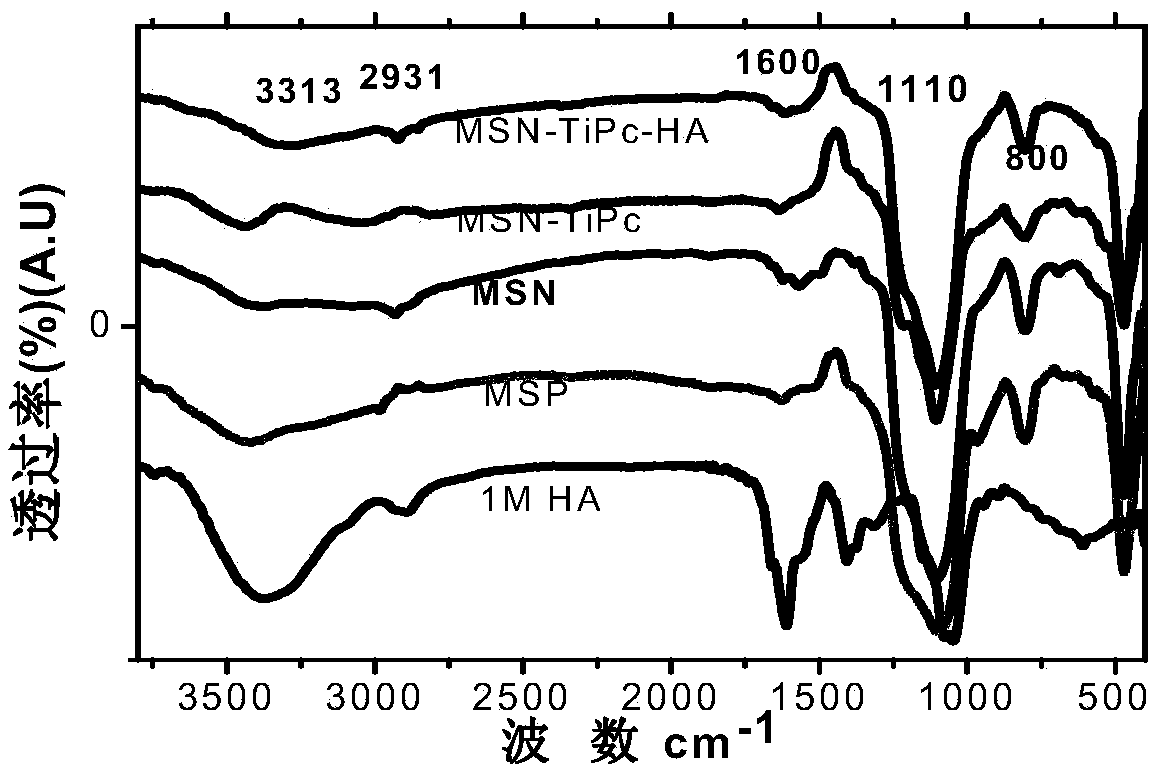Biological photosensitizer
A photosensitizer and biological technology, applied in the direction of drug combination, medical preparations of non-active ingredients, powder delivery, etc., can solve the problem of increased side effects of photodynamic therapy, poor photodynamic therapy effect, and poor absorption rate of non-targeted nanoparticles. advanced questions
- Summary
- Abstract
- Description
- Claims
- Application Information
AI Technical Summary
Problems solved by technology
Method used
Image
Examples
Embodiment 1
[0019] Embodiment 1: the preparation of biological photosensitizer
[0020] 1) Amino groups on the surface of mesoporous silica-coated upconversion nanoparticles (NaYF4:Yb / Er):
[0021] Weigh 15 mg of mesoporous silica-coated upconverting nanoparticles (NaYF4:Yb / Er), add it to a vial containing 3 ml of toluene solution, seal it and rotate at 300 rpm for 6 hours at room temperature (the rotation speed should not be too fast, not exceeding 600 rpm) . Then add 50 ul of APTMS (volume ratio toluene:APTMS=60:1), and the solution is sealed and rotated at room temperature for 24 hours. After the rotation, the nanoparticles were collected by centrifugation at a relative centrifugal force of 3500 g for 6 minutes. Take 3ml of toluene solution, pipette the solution until the particles are evenly mixed, and the solution becomes a suspension, then centrifuge to collect the nanoparticles, the relative centrifugal force is 3500g, the time is 6min, repeat the above steps, wash with 3ml of to...
Embodiment 2
[0028] Embodiment 2: the preparation of biological photosensitizer
[0029] 1) Amino groups on the surface of mesoporous silica-coated upconversion nanoparticles (NaYF4:Yb / Er):
[0030] Weigh 30 mg of mesoporous silica-coated upconverting nanoparticles (NaYF4:Yb / Er), add it to a vial containing 3 ml of toluene solution, seal it and rotate it at room temperature at 300 rpm for 6 h (rotation speed should not be too fast, not exceeding 600 rpm) . Then add 50 ul of APTMS (volume ratio toluene:APTMS=60:1), and the solution is sealed and rotated at room temperature for 24 hours. After the rotation, the nanoparticles were collected by centrifugation at a relative centrifugal force of 3500 g for 6 minutes. Take 3ml of toluene solution, pipette the solution until the particles are evenly mixed, and the solution becomes a suspension, then centrifuge to collect the nanoparticles, the relative centrifugal force is 3500g, the time is 6min, repeat the above steps, wash with 3ml of toluene...
Embodiment 3
[0038] The biological photosensitizer of the invention can be used for efficient and strong targeted photodynamic therapy of deep tissue. The larger the wavelength of the light, the stronger the tissue penetration ability, and the near-infrared light can reach the deep layer of the tissue. β-NaYF 4 : Yb / Er up-conversion nanoparticles of this crystal phase can absorb near-infrared 980nm laser light and emit visible light with wavelengths of 520nm, 540nm and 653nm. Photodynamic therapy of deep tissue can be realized by loading photosensitizer on it.
[0039] The present invention loads phthalocyanine titanium dichloride and hyaluronic acid onto mesoporous silica-coated upconversion nanoparticles (NaYF 4 :Yb / Er), hyaluronic acid can specifically recognize cancer cells with overexpression of CD44, such as: colon cancer cells and breast cancer cells, etc., endowing the biophotosensitizer with high targeting. Titanium phthalocyanine dichloride, a photosensitizer, has a high energ...
PUM
 Login to View More
Login to View More Abstract
Description
Claims
Application Information
 Login to View More
Login to View More - R&D
- Intellectual Property
- Life Sciences
- Materials
- Tech Scout
- Unparalleled Data Quality
- Higher Quality Content
- 60% Fewer Hallucinations
Browse by: Latest US Patents, China's latest patents, Technical Efficacy Thesaurus, Application Domain, Technology Topic, Popular Technical Reports.
© 2025 PatSnap. All rights reserved.Legal|Privacy policy|Modern Slavery Act Transparency Statement|Sitemap|About US| Contact US: help@patsnap.com

